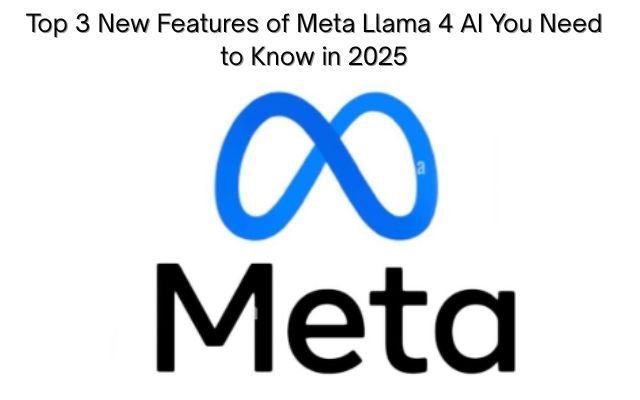Top 3 New Features of Meta Llama 4 AI You Need to Know in 2025
Discover the top 3 new features of Meta Llama 4 AI in 2025, including better performance, multimodal support, and more.

Meta launched its new Llama 4 AI models in April 2025. These models are much better than the older Llama 3 versions. They give smarter answers, work faster, and have more helpful features. Meta Llama 4 is made to take Meta’s AI to a higher level. Whether you’re a developer, a researcher or just someone interested in AI, Llama 4 has cool updates you should know about. In this article we’ll look at the top 3 new features of Meta Llama 4 AI and why they are important.
Understanding Mixture of Experts (MoE) Architecture
New Mixture of Experts (MoE) architecture is one of the most notable aspects of Llama 4 models. This method is different from previous models & is the first for the Llama series. MoE design only activates a portion of the model’s parameters for each token, compared to conventional dense transformer models like Llama 3, where all parameters are triggered for every task.
For example, Llama 4 Maverick activates just 17 billion parameters out of 400 billion, using 128 routed experts and a shared expert. The smaller Llama 4 Scout has 109 billion parameters but only uses 17 billion with 16 experts. The largest model, Llama 4 Behemoth, activates 288 billion parameters out of nearly two trillion, with 16 experts assigned to each task.
This change significantly improves the training and inference efficiency of Llama 4 models. Lowering the number of parameters activated lowers expenses, delay & total resource use. Llama 4 models can operate on a single Nvidia H100 GPU because of the MoE architecture which is remarkable given the quantity of parameters required. Other AI models such as ChatGPT, on the other hand, usually require more Nvidia GPUs for each question which raises resource requirements.
Built-in Multimodal Support in Llama 4 AI
Another major improvement in Llama 4 AI models is their built-in multimodal processing. This means the models can understand both text and images at the same time.
Early in the training process, Meta used text and visual data to do this. The models were able to learn more naturally and adaptably since they were trained on a wide variety of text, image and even video data.
In the past, with Llama 3.2 (released in September 2024), Meta had to release separate models for vision and text. But with Llama 4, that’s no longer necessary—thanks to native multimodal support, one model can handle both.
Llama 4 also includes a stronger vision encoder, which helps it understand more complex visual tasks and work with multiple images. This makes the models useful for a wide range of real-world applications that need both text and image understanding.
- Top 5 Smart TV Apps That Work Without Internet
- Losing Your Google Account: What It Means and How to Stay Safe
- Simple Ways to Check If Your ISP Is Throttling Your Internet Speed
Llama 4 AI Models Offer a Massive Context Window of Up to 10 Million Tokens
One of the most powerful upgrades in Meta’s Llama 4 AI models is the expanded context window which now supports up to 10 million tokens. This means Llama 4 can process input text that’s over five million words long—a huge leap from the earlier Llama 3 model, which started with just 8K tokens and later extended to 128K after the Llama 3.2 update.
Llama 4 Scout brings a big upgrade with support for up to 10 million tokens, setting a new standard in the AI world. Even Llama 4 Maverick with a 1 million token limit, shows great progress. Llama 4 Behemoth is still being trained but it’s expected to be even more powerful when it’s ready.
This improvement puts Llama 4 ahead of other top models like Gemini (2 million tokens), Claude 3.7 Sonnet (200K), and ChatGPT’s GPT-4.5 (128K). A bigger context window means the AI can better handle long conversations, multiple documents, large code files, and complex tasks.
With Llama 4 Meta is concentrating on enhancing real-world performance rather than merely adding features. The Llama 4 series is one of the most powerful and adaptable AI models on the market right now, especially when combined with the new MoE architecture for increased efficiency and native multimodal support for text and image inputs.
FAQ
1. What is Meta Llama 4 AI and when was it released?
In April 2025, a new set of AI models called Meta Llama 4 was introduced. Following Llama 3, it is the most recent update, providing improved features, quicker performance, and more intelligent responses.
2. What is special about the Mixture of Experts (MoE) architecture in Llama 4?
Compared to prior versions like Llama 3, Llama 4 is faster and less expensive to run because of its MoE architecture which limits the amount of its brain (parameters) used for each task.
3. Can Llama 4 understand both text and images?
Yes, Llama 4 has built-in multimodal support. It can process text and images together, making it more useful for tasks like visual reasoning or image-based queries.
4. How long can conversations or inputs be in Llama 4?
Llama 4 can handle up to 10 million tokens (about 5 million words), which is much longer than previous models and perfect for big projects or long chats.
5. Why is Llama 4 better than Llama 3 or other AI models?
Llama 4 is faster, more efficient, and smarter. It has a new MoE setup, supports both text and images, and has a huge context window—making it a strong competitor in the AI space.



